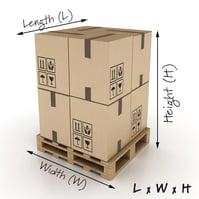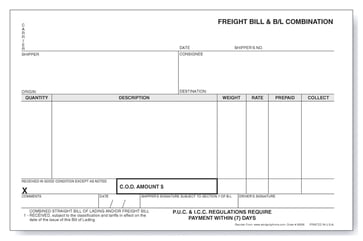What Are Freight Rebills, and How Can I Avoid Them?
Carrier Relations | Business Advice | Logistics | Transportation | Best Practices | Freight Rates | Freight Management | Shippers | Freight Broker
Have you ever opened a bill to find out you owe more than originally quoted? Not fun! But it happens, and the logistics industry is no exception. A billing adjustment, commonly called a "rebill," occurs when the shipment is inspected, and the carrier adjusts the original invoice rate. This may occur at different stages in the invoicing process. A rebill can be issued before or after a discrepancy is found during the auditing process.
 Carriers often generate rebills based on discrepancies in the number of items, weight, class, NMFC code, or shipment size compared to how the load was quoted. Rebills can also occur when additional/labor-intensive service is needed or when there is excessive detention, generally at air cargo or ocean cargo facilities. (Most carriers only allow 15-30 minutes free wait time before they charge anywhere from $80-150 per hour.)
Carriers often generate rebills based on discrepancies in the number of items, weight, class, NMFC code, or shipment size compared to how the load was quoted. Rebills can also occur when additional/labor-intensive service is needed or when there is excessive detention, generally at air cargo or ocean cargo facilities. (Most carriers only allow 15-30 minutes free wait time before they charge anywhere from $80-150 per hour.)
Rebills tend to be more common in less-than-truckload (LTL) shipments because of the precision they require and the complexity of rate determination. In the truckload world, carriers reach out to the person arranging the freight and request a new rate confirmation before delivering the load. This process reduces the number of rebills, that is, if everyone can agree on the extra charges. (But that’s a whole different blog!)
If you’re unfamiliar with the requirements and pricing of specialty LTL carriers, it’s best to rely on a broker or transportation manager who knows your product and shipping needs to avoid unpleasant surprises. From truckload to LTL, these are best practices that the shipping experts at Armstrong use and a way to start reducing those pesky rebills.
Weigh Your Freight
Do you have a habit of weighing yourself at home only to be shocked by the scale at your doctor’s office? “Maybe it’s the shoes?” (It’s never the shoes, is it?) Weight discrepancies are the most common source of billing adjustments. Shippers frequently add the weight of the shipment and pallet together or round to the nearest 100 pounds. Weighing the shipment with a commercial scale will provide more accurate numbers than estimating. Like clothing, remember that packaging adds weight; record the numbers once the freight is fully prepared for shipment.

Measure the Dimensions
An $8 measuring tape can save you money. Invest today! Dimensions are commonly guesstimated by shippers, making them another frequent source of rebills. Take time to obtain exact freight measurements because the carrier will. You should also keep spec sheets or packing lists with detailed information on weight and dimensions; these can help resolve disputes should there be a discrepancy between your measurements and the carrier's.
Understand Your Shipping Class
Freight classification is a critical component in shipping rates. There are 18 classifications ranging from 50 to 500 as determined by the National Motor Freight Traffic Association. Lower-class shipments are denser and easier to stow and handle, lowering the rate. Shipments with higher classifications take up more space relative to weight and often require special handling to prevent damage. Having correct weights and dimensions is crucial. Online tools like ClassIT can help you determine the right classification.
Know Your Locations
.png?width=380&name=Truck%20at%20a%20Church%20(PS).png)
Carriers charge extra when picking up or delivering at nontraditional locations like residences, schools, hospitals, self-storage facilities, and churches. These sites often require smaller trucks and can make maneuvering or offloading more difficult. Google Maps is a great tool for avoiding a rebill due to location. Take a few minutes to see what the delivery location looks like before obtaining a quote, and be upfront with your carrier or broker about what's on the other side of your shipment. Access may be limited, or certain services (e.g., liftgates) may be required to complete the delivery.
Request Accessorial Services in Advance
Anything out of the norm or requiring extra time or effort will incur additional fees. The best way to prevent surprises is to know what commodity is being shipped and discuss in advance with your broker, carrier, or receiver any additional services required at pickup and delivery.
Liftgates, for example, frequently necessitate rebills; knowing what equipment you need to load and unload a shipment before quoting is crucial. If the carrier arrives without the proper equipment, you’ll be charged not only for liftgate delivery but also for rescheduling the pickup or delivery appointment. You should also know the receiver's hours of operation and whether or not the business closes for lunch to prevent delays and rescheduling.
Review All Paperwork Carefully

Taking time to review the paperwork and communicate with all parties drastically reduces the chance of a rebill. The BOL can make or break a shipment. Making corrections to the BOL mid-transit, such as changing the delivery address or bill-to party, can be very costly. You should also carefully review the POD paperwork to ensure no additional fees or services are listed beyond what was quoted.
At Armstrong, we have a billing team that only bills loads moved by LTL carriers. They understand the process and have a rapport with carriers, making it easier to navigate rebills. Adjustments are a part of the process; the best we can do is reduce the amount and mitigate the risk.
A 3PL Can Help
Having accurate information upfront is crucial when gathering quotes. If you're struggling to identify what accessorial services you need or require help assessing and classifying your freight, reach out to us today. A reliable logistics partner goes a long way in resolving headaches and preventing unexpected charges.
About Landyn Fassett
Landyn Fassett serves as a team member for Armstrong's LTL department, handling billing and operations. She originally joined Armstrong in 2017 to focus on AP, soon moving to our AR department. She then progressed as a team lead in our Billing department before transitioning to her home in LTL.



